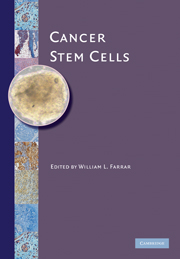Book contents
- Frontmatter
- Contents
- Contributors
- Preface
- SECTION I CHARACTERIZATION OF CANCER STEM CELLS
- SECTION II THERAPEUTIC IMPLICATIONS OF CANCER STEM CELLS
- SECTION III TARGETING CANCER STEM CELL PATHWAYS
- 7 Hedgehog/GLI signaling in cancer
- 8 Targeting the Notch signaling pathway in cancer stem cells
- 9 TGF-β, Notch, and Wnt in normal and malignant stem cells: differentiating agents and epigenetic modulation
- Index
- Plate section
- References
7 - Hedgehog/GLI signaling in cancer
from SECTION III - TARGETING CANCER STEM CELL PATHWAYS
Published online by Cambridge University Press: 15 December 2009
- Frontmatter
- Contents
- Contributors
- Preface
- SECTION I CHARACTERIZATION OF CANCER STEM CELLS
- SECTION II THERAPEUTIC IMPLICATIONS OF CANCER STEM CELLS
- SECTION III TARGETING CANCER STEM CELL PATHWAYS
- 7 Hedgehog/GLI signaling in cancer
- 8 Targeting the Notch signaling pathway in cancer stem cells
- 9 TGF-β, Notch, and Wnt in normal and malignant stem cells: differentiating agents and epigenetic modulation
- Index
- Plate section
- References
Summary
Cancer is among the leading causes of death worldwide, and its incidence is continuously on the rise. Successful therapies of this disease are a major challenge and aim of this century. Understanding the molecular programs that control the malignant behavior of tumor cells, particularly of those that account for tumor initiation, growth, and metastasis, will be key to the development of targeted cancer therapies.
Cancer arises through the accumulation of genetic and epigenetic alterations that gradually endow the tumor cells with more aggressive growth properties, eventually leading to the spreading of cancer cells to form metastases. Over the past years, numerous studies have provided compelling evidence that many malignancies are driven by cancer stem cells, a small subpopulation of tumor cells with self-renewal and tumor-initiating capacity. Targeting the molecular signals that control self-renewal, survival, and proliferation of cancer stem cells is therefore considered a highly promising approach to tackle cancer at its very roots.
A series of recent studies has implicated the Hedgehog/GLI (HH/GLI) signaling cascade in the development of a variety of human malignancies, and there is increasing evidence that this developmental pathway plays a critical role in cancer stem cells, making it a primary target for novel and efficient cancer therapies. This review will give an overview on recent insights into the mechanisms of Hedgehog signal transduction, summarize key findings about the involvement of HH/GLI signaling in cancer development, and finally, concentrate on the role of HH/GLI in stem and cancer stem cells and its relevance to potential future therapies.
- Type
- Chapter
- Information
- Cancer Stem Cells , pp. 109 - 127Publisher: Cambridge University PressPrint publication year: 2009

